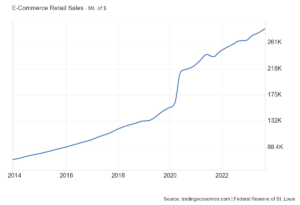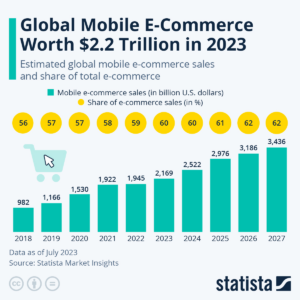- E-commerce revenue in the US hit $910 billion in 2023, projecting a +10.4% growth.
- 20.8% of retail purchases are now online, with an additional +9% expected in 2024.
- Maximize your success with the latest techniques using our comprehensive guide!
Mobile-first design
👉 It’s become clear in 2023 that Mobile devices are now the primary platform for online shopping, and are now set to contribute nearly $4.5 trillion to global ecommerce sales by 2024, constituting 70% of all transactions.

It’s clearer now more then ever before the necessity for brands to adopt a mobile-first strategy for not only SEO benefits, but also the customer satisfaction and sustained relevance.
Utilizing a mobile-first design approach centers on more then the self-explanatory obvious first impression. Yes of-course it must load on Mobile rapidly and look great on the small screen, but don’t stop there on optimizing user experience (UX) for smaller screens.

Mobile-first involves crafting Portrait and Landscape layouts with fixed heights to avoid CLS issues, it’s also thinking about ‘touch target size’ of around 7-10mm when building your CSS and sections thinking about touch-based interactions and not clicks.
 © Steven Hoober
© Steven Hoober
Be mindful of obscured areas

It’s also about refining navigation and checkout processes for efficiency without a keyboard and mouse in a world where native apps, apple pay, google pay et al already ‘just work’.
The customer expects yours too just flawlessly guide them through the process on their device. Simple pitfalls such as items being off-screen or being fiddly to use on Mobile will ultimately result in lower conversion rates due to friction.
These elements are pivotal for reducing user friction and boosting conversion rates on mobile platforms.
Since 2019, Google’s been pushing Mobile-first indexing, and the trend has only continued to grow. Embracing a mobile-first strategy aligns brands with both evolving consumer preferences, and the SEO requirements for Google’s Core Web Vitals aware algorithm, which is getting more and more iterations and improvements with every passing quarter.
Being Mobile-first in all planning positions Store owners to thrive in the mobile-centric landscape of global e-commerce; which is most definitely where your mind needs to be to hit new highs in 2024.
Social Proof is crucial
📈 According to a recent study, customers now anticipate the use of social proof, and its implementation can result in a remarkable +34% increase in conversions.
Incorporating your social media as a form of proof, is the easiest way to validate yourself online as a legitimate business.
It’s so powerful that is has the potential for abuse, which we see all the time with scams, as younger people tend to put more trust in active social media accounts – simply because of a organic familiarity due to the frequency in which they see their posts and view their content.
This now common place behavior has lead to Meta adding warnings in Instagram and Facebook DMs and tightening reporting.
Store owners have 2 crucial objectives here: First to make sure to have visible brand awareness, and secondly; also to make sure no one setups a fake account to impersonate them.
💡 Social-proof has the potential to significantly enhance conversions for your online store.
In a nutshell; Utilizing social proof involves showcasing interactions between customers and your products.

Best Practices for Social Proof
When creating your posts and stories, it’s ideal to use the following game plan to ensure your content is conveying the following points:
- Bringing attention to best sellers, the frequently purchased items are the stars of the show.
- Being candid and open about analytics, publicly displaying the number of users viewing a product via a legitimate screenshot. You can partially obscure sensitive data like personal account details and names etc, but being able to see behind-the-scenes is what the customer is here for.
- Tagging customers that recently bought products. This is the golden standard, having a tag from a consumer who’s made their own video with their review is the ultimate goal here. This can be incentivized with giveaways, coupons and promos.
Why does Social Proof work?
The phenomenon occurs because customers tend to align their buying decisions with popular choices or interests of other buyers. Essentially as a group or by being shepherded in as a herd.
The presence of frequently bought products guides customers to decisions that resonate with others. Everyone looks for something to buy to help them, improve their life in someway or just simply wants to have fun. Their interests differ but your demographic all have relatively the same basic needs and desires.
So with this in mind, showcasing recent purchases instills a Fear of Missing Out (FOMO) into the followers, prompting customers to make a purchase due to high demand and the perception of trendiness, or simply because it is new and they love this niche, it’s why they work after all – to have nice things.
It’s the combination of frequency, relevancy and engagement, that culminate into creating the wonder of social proof. When it all comes together for example with popular YouTube content, we see brands hit new all time highs that far surpass any expectations, and sell out their stock in a day!
More coming in the next episode:
Thanks for reading! I hope you got some great ideas brewing now from the strategies outlined thus far, if you need any assistance in getting your implementations started, contact us to arrange a free consultancy in the new year and get the ball rolling for you 👍
Check back again soon for the next part of this guide where I’ll be going over:
- Importance of a fast and modern checkout process
- High-quality images and product video
- The power of a solid product recommendation strategy
- Email marketing never dies
- How to effectively use live chat and using AI chatbots

Leave A Comment